List of Authors
>>About this blog
Recent blog post
|
[Kra-san]
February 29, 2016 18:00
On the way of a walk last weekend, I saw a poster (pictured) of "Peach Festival Hina Matsuri" at Sanko Inari Shrine in Nihonbashi Horidome-cho, so I would like to introduce this Inari.
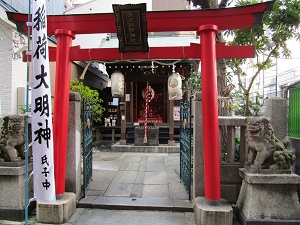 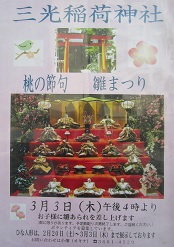
Sanko Inari Shrine was Osaka's Kabuki actor Sanjuro Seki, who appeared in Nakamura-za, even though the Kinubu wholesaler Tawaraya Village Koshi Shozaemon and cotton wholesaler Tateishi Sanzo, who lived near the area (formerly Hase Kawamachi), was recommended in the early Edo period. It is said that it was Fushimi since 1689 (Genroku Kan 2). The shrine hall was burned down in the Great Kanto Earthquake of 1923 and rebuilt in 1924 (Daisho 13). In the same year, Hase Kawamachi and Tadokoromachi merged into Horidome 2-chome, at which time Tadokoro Inari Daimyojin was enshrined. Later, at the time of land readjustment in 1933 (Showa 8), he was transferred to his current location, and the street came to be called Sanko Shindo.
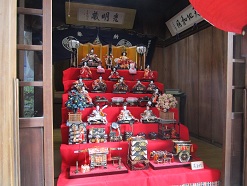 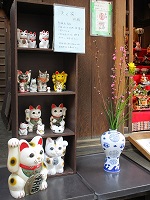
Basically, it is an unmanned company, and vermilion seal stamp and others can be awarded at Ningyocho-dori at the fourth cosmetics store Okina (Mr. Obata). According to Mr. Obata, various events have been held every season, including the peach festival (Hina Matsuri), for a long time, but the display of doll decorations seems to have started about ten years ago. The five-tiered doll decorations (pictured) on the worship hall are impressive with a presence that creates a gorgeous and dignified atmosphere. In addition, Sanko Inari Shrine has long been visited by daughters, children, geisha, etc., and it is said that if you make a request when you lose sight of cats as a cat tribe guardian angel. The beckoning cat (pictured) on the precincts is said to have been dedicated by the owners who have returned the cat.
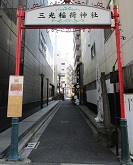 
The location is on the north side of the subway Ningyo Station, located in the back of a narrow side street on the east side of Ningyocho-dori (in the direction of Kodemmacho), and at the entrance there is a stone sign (pictured) of Sanko Inari Shrine approach. It is a small Inari Shrine that is a bit difficult to understand, but if you are interested in the Hina Matsuri held on March 3 (Thursday) and cats, why not visit once?
[CAM]
February 25, 2016 12:00
The other day, he appeared on "Chuo FM" and "I love Chuo-ku" and talked a little about "Hyowa clogs" and "Shokutei Nijo" in Kafu. So, I thought about what time I posted on this blog before, and when I checked it, it was on November 30, 2015.
Then, for about three months, if you stroll around Chuo-ku on the right of the wind "Hyori Geta" or "Shokutei Nijo", you will become quite familiar with the old place names that have disappeared now. Become.
I would like to record the previous sentence again.
"I don't have any obligation or responsibility to do this, so it's just like retirement. As I sent that day, one of the results of devising various ways to spend money without going out to the world, do not need someone, do not need someone, and swallow yourself alone, was a wandering around the city. " (13-301)
And "Sunday clogs" is a walking note that spells what the wind felt in the daily "hanging walk".
In the "Introduction", "I'm about a year old at the beginning of the summer of 1914, serialized in the magazine Mita Literature every month," says, "When I'm ready to go out to the world, I'm going to be a scenic view of the city, and there's no trace that has already been destroyed. " That's why he says, "Let's tell the story of the dream world that will be the tide of yesterday, and this small book, fortunately, will it be a seed of the later day or grass."
Indeed, after that, the Great Kanto Earthquake of 1923 (1923), the U.S. military raid in 1945, and the Tokyo Olympics in 1964, it has been a long time since "the time when this paperboard is formed and it will appear in the world." Now, "I have been able to read this 9th anniversary, and I have already been destroyed.
The scenery in Chuo-ku does not appear so much, but I would like to pick up some of them.
"Edo famous places do not have landscapes or architecture that must be proud of for a long time. ・・ ・ Tsukuda Island, which relocated Sumiyoshi, did not endure the history of Sobashi on a few Kishi Himematsu's shore ... The corner was the only masterpiece of Edo famous places that was only sunny Fuji. . " (300)
"A row of trees is the most effective in downtown areas. Ginza Komagata Ningyocho Dori's willow tree shades and summer night stalls are worthy of a large industrial factory under the Fukidori star without a blowing winder. " (315)
`` Shirakawa Rakuo, a gunshot, is one of the Edo Meien, along with Koishikawa's Korakuen, is one of the Edo Meien, but nowadays the Navy's military members gather and drink. It's a thing of a club that drinks sake. " (320)
"Every time I walked along Nihonbashi Odori and looked at Mitsui Mitsukoshi and other high American-style shops that compete in this area, I knew what a businessman in Tokyo truly called Nihonbashi and Surugacho, if I had a legendary interest in this, I would have even thought of preserving the distant view of Mount Fuji from a busy city. (327)
"In discussing the waters of Tokyo, the first is the sea bay of Shinagawa, the second is the natural river such as the Sumida River Nakagawa Rokugo River, the third is the Edogawa River of Koishikawa, the Kanda River of Kanda, and the Otonashi River of Oji, the fourth is the Shitaya Shinsho Nihonbashi Kyobashi Shitaya, the fourth is the beauty of Shinindigo dyeing. (332)
Walking and walking are now walking in the wind, would it be walking? Kafu still says that he should use money because he has money, but in my case, he said that he has no genuine money, and said, `` As I send that day, I will not go to the public and I will continue to walk around Chuo-ku in the future as a method of swallowing myself without requiring me. "
[CAM]
February 23, 2016 12:00
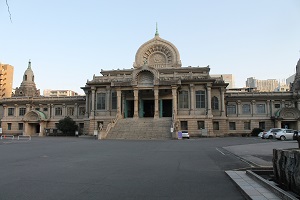 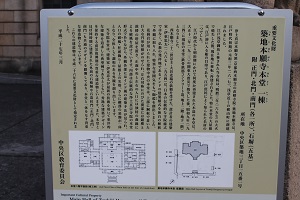
Important Cultural Properties
main hall, Tsukiji Honganji
Attached main gate, north gate, south gate (one place each), stone wall (five units)
Location 3-15-1 Tsukiji 7, Chuo-ku, Chuo-ku
Tsukiji Honganji Temple, a temple under the direct control of the Jodo Shinshu Honganji Temple (Kyoto Nishi Honganji Temple), was founded in Yokoyamacho, near Asakusa in 1617 (1617) during the early Edo period.
This temple, called Edo Asakusa Gobo, was destroyed by the great fire of 1657 (1657), and was relocated and rebuilt to its current location. In particular, the large roof of main hall was a landmark for ships entering Edo Minato, and was one of the most well-known landmarks of the Edo people.
The wooden main hall, which was rebuilt several times between the Edo and Meiji periods, was burned down by the Great Kanto Earthquake of 1923 in 1923 and then became the current main hall (reinforced concrete, two floors above ground and one floor below ground) in 1934.
ITOCHU Ta (1867-1954), an architect of the designer at the request of Nishi Honganji Temple's 22nd lord, Ko Otani Hata, created the temple complex with a unique interpretation of Indian architecture, which was the birthplace of Buddhism, instead of traditional Japanese temple style.
main hall, located in the center of the granite building, has a huge circular roof with a copper plate on the top, a bell tower and a drum tower on the symmetrical wings, and a unique curve gable at the center of the front and the left and right entrances. Although the interior is in the main hall style of the traditional Jodo Shinshu temple, Indian-style architectural techniques are seen in each part of the exterior, and the gables at the entrance (hafu), stills on the roof, and detailed decorations are integrated to create a harmonious appearance as a whole.
The main hall of this temple is a typical example of the architect ITOCHU Ta pursuing Orient-style architecture using the latest technology, and it can be said that it is a valuable building during the reconstruction period that retains excellent architectural design. In addition, the masonry walls and stone pillar gates (main gate, north gate, south gate) built around the same time as main hall aremain hall's valuable buildings.
These buildings were designated as important cultural properties in 2014.
March, 2015
Chuo-ku Board of Education
Signal version of nationally designated important cultural properties
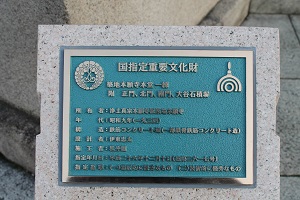 On the premises, stone lantern (this is not an important cultural property) On the premises, stone lantern (this is not an important cultural property)
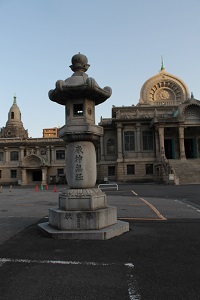 Shinran saint statue on the premises (this is not an important cultural property) Shinran saint statue on the premises (this is not an important cultural property)
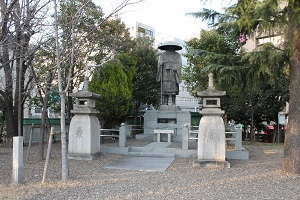 The main gate and masonry fence, which are part of important cultural properties The main gate and masonry fence, which are part of important cultural properties
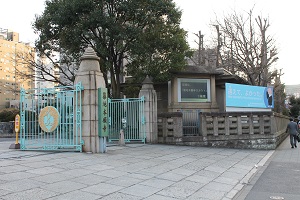 South Gate, a part of Important Cultural Properties South Gate, a part of Important Cultural Properties
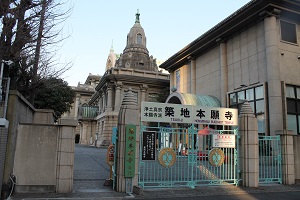 There is also a cafe and accommodation on the premises. There is also a cafe and accommodation on the premises.
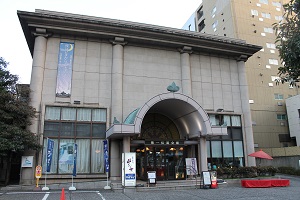
[Tachibana]
February 17, 2016 18:00
It is "Uokawagishimizu Shrine Haruka worship place" in Tsukiji Market that everyone knows well.
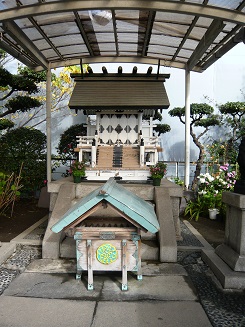
In front of the shrine, there is a stone monument of "Hagiyama" commemorating the birthplace of the Navy.
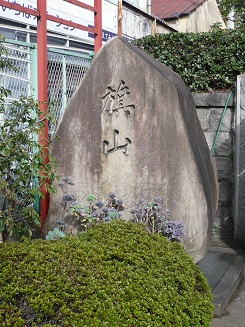
In the explanation version at Mizu Shrine, "Mizu Shrine" main hall was erected in 1901 on the grounds of Kanda Myojin.
I've seen main hall at Kanda Myojin.
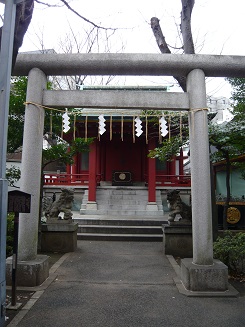 
This is the main hall of the fish riverbank water shrine in Kanda Myojin.
In this explanatory version,  "Nihonbashi Fish Bank Water Shrine" was enshrined by the fish bank ancestors in order to pray for great fishing safety along with the Tokugawa family's military luck Nagahisa, and was renamed "Mizu Shrine" in guardian angel in Nihonbashi Fish Market in 1891. After the fish market moved to Tsukiji, a place of worship was built in Tsukiji Market, which is supported by the strong religion of the people involved in the market. "Nihonbashi Fish Bank Water Shrine" was enshrined by the fish bank ancestors in order to pray for great fishing safety along with the Tokugawa family's military luck Nagahisa, and was renamed "Mizu Shrine" in guardian angel in Nihonbashi Fish Market in 1891. After the fish market moved to Tsukiji, a place of worship was built in Tsukiji Market, which is supported by the strong religion of the people involved in the market.  It is written. It is written.
In addition, from Kanda Myojin, "Uogashimizu Shrine" is positioned as "subsidiary shrine" related to shrine parishioner Town.
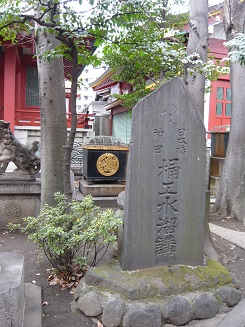 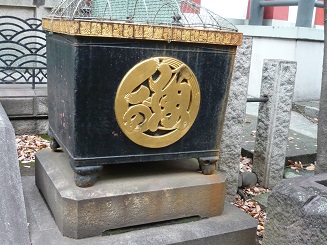
[Mido]
February 16, 2016 18:00
I have taken the 8th Chuo-ku Tourism Certification Examination.
I have taken the exam twice (2nd and 5th) in the past.
I think the difficulty was high this time.
In particular, the questions related to historical buildings were particularly noticeable.
I'll do it.
Photography Question What is this building at Tsukiji 1-chome?
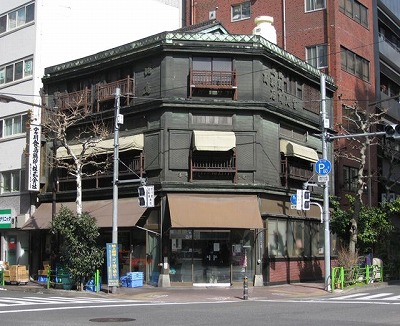
The correct answer is Miyakawa chicken egg
What are the characteristics of the Yonai Building in Ginza 2-chome?
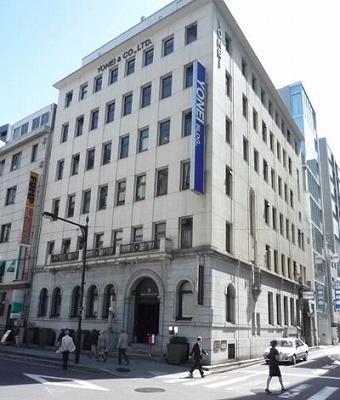
The correct answer is a romanesque-style twisted pillar
What are the characteristics of the pillars of the Hario Glass Building in Nihonbashitomizawacho?
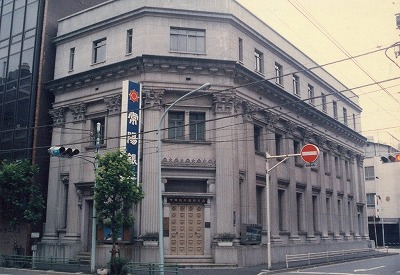
The correct answer is a colint type
What is the designer of Bunjiro Tamaki Building in Higashi Nihonbashi 2-chome?
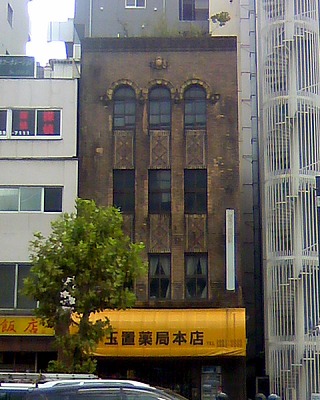
The correct answer is Matsunosuke Moriyama
------------
How was it?
In addition, there were three other questions about the building.
It was a difficult problem.
But from this point of view, you can walk around the city with a camera.
I think it's fun.
[Nanako Tsukishima]
February 15, 2016 14:00
 The stage of the popular morning drama "Asaga came" is Osaka, but what is The stage of the popular morning drama "Asaga came" is Osaka, but what is  the popular Tomoatsu Godai who surpasses the leading role? the popular Tomoatsu Godai who surpasses the leading role?
There was a connection here in Chuo-ku.
This time, I will follow the footsteps in the ward of the fifth generation.
After the Meiji Restoration, the new government prepared for trade with other countries and provided money that had been inferior in the late Edo period.
It was necessary to improve the quality of international standards.
One of the five generations was entrusted with this Western-style money making.
As he proceeded with this work, he worked on the mining business to obtain gold and silver.
As a management office, Hironarikan was founded in Nakanoshima, Osaka, where his home was located in 1873.
In 1874, we also started the management of Handa Ginzan in Fukushima Prefecture, and as a base for this project, we entered 8-chome Tsukiji Irifune, Tokyo.
"Higashi Hironarikan" was set up.
Is it around the birthplace of St. Luke Hospital and Ryunosuke Akutagawa in today Akashicho?
In the drama, he took a boat and train from Osaka and walked through the brick street from Shimbashi to Tsukiji.
In the scene where the gas lamps turn on, the fifth generation said, "85 gas lamps illuminate the street between here and one ri."
There was also a word.
I understand the modern city of Chuo-ku, Tokyo, which has been modernized.
Five generations who have completed their 49-year-old life at a separate residence in Tsukiji without the help of recuperation.
The fact that the fifth generation, famous as the "man who made Osaka", had a connection with Tsukiji until the end.
I feel proud of it.
There is no turn in the drama anymore, but it reappears in my dream on the 22nd of this month.
I'm really looking forward to it.
Dean, you can meet your fifth generation 
|
Links
|

















